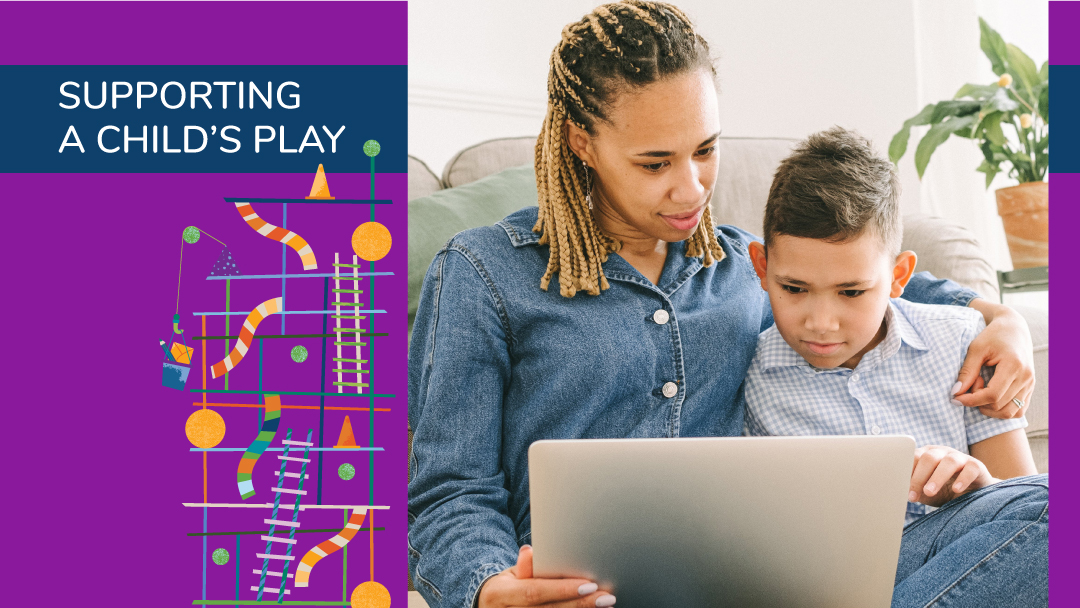
Three Tips to Get the Most Out of Screen Time for Kids
Guest blog by Erin Walsh, Spark & Stitch Institute
I’ve spent my career translating research on the media’s impact on child health and development. Lots of parents and caregivers are worried about creating digital balance for their kids, but there’s no need to add screen time guilt to your long list of stressors. Instead, focusing on key takeaways from scientific research can help guide our screen time choices and prioritize the relationships and experiences our kids need for healthy development. Here are three places to start:
1. Use screen time as a relationship-building exercise
For young children especially, learning is intensely social. Study after study shows that engaging with technology alongside your child helps them get the most out of it.
However, the reality is that screen time often provides a window of opportunity to make dinner, take a break, get ready for a second work shift or get your other child down for a nap. So, if sitting down next to your child isn’t possible, find ways to bring digital experiences back into the context of your relationship at other times.
For example:
- Ask your child questions about the show they watched. Ask them to describe the characters and story and relate it to offline observations and experiences.
- Read books related to the themes of their favorite shows and talk about how they are similar and different.
- Use Legos, animals or figurines to encourage play that builds on and expands the storylines in their favorite shows or games.
- Encourage your child to use media as a tool for connecting with siblings, grandparents or friends.
2. Find technology that promotes playful learning.
While we tend to marvel at children who can recite their numbers and letters, the real work of the early years is in practicing emotional regulation, creative problem solving, persistence, empathy and other skills that fall under the umbrella of executive function. Children learn these skills in the context of warm, caring relationships and by doing what they love best: playing.
Unfortunately, too many apps take a “drill and practice” approach to learning, focusing on very basic skills like naming letters, sounds and words. While knowing numbers and letters is important, it doesn’t provide the rich literacy-building play that children could be engaged in when they create signs for the door of their castle or sing songs and learn new words.
Resist the urge to download apps that operate only under what Warren Buckleitner, founding editor of “The Children’s Technology Review,” calls “smother mode.” For example, rigid instructions and constant rewards for performing prescribed tasks. Instead, try to find apps and games that honor the spirit of free play.
Do your child’s apps and games:
- Encourage imagination, creativity and open-ended exploration?
- Encourage perspective taking or creative problem solving?
- Have an appropriate storyline that children can expand on offline?
3. Set boundaries where they matter most.
Make sure that technology time is used in addition to rather than as a replacement for offline connection and play. Setting predictable boundaries helps reduce power struggles and helps you prioritize setting limits where they matter most to your child’s development.
Consider:
- Content: Choose age-appropriate media. Use PBS Kids for age-appropriate shows and games. Here is a list of great sites that help you find creative apps for your kids.
- Timing: Pay attention to the timing of tech use. For example, avoid media before or during bedtime and reduce background media during play.
- Routine: Create predictable screen-free spaces to reduce constant negotiation. You could start by making sure that meals, bedtime and car rides are all screen free since these are times for conversation and connection.
If you feel like your child is getting more screen time now than they should, you’re not alone. But by going easy on yourself and following the tips above, you can relax knowing that you are making positive choices for your child’s development.

When it comes to the topic of balancing screen time with other activities in a healthy and practical way, we can’t think of someone more versed on the topic than Erin Walsh of Spark & Stitch. Walsh is a brain science expert who specializes in practical strategies for raising connected kids both online and offline, and she has put together her top three tips for how parents can get the most out of their kids’ screen time.
Erin Walsh is also co-founder of Spark & Stitch Institute, an organization committed to sparking greater understanding of why kids need courage and connection to thrive and how to foster it in the digital age. For nearly 20 years, she has worked to bring scientific research and relatable tips to families and educators across the country.

SUPPORTING A CHILD’S PLAY
SUPPORTING A CHILD’S PLAY
Playful Mindset Turns Chore Time into Play TIme
There’s no way around it: There are always chores to do and errands to run.
Those responsibilities don’t have to be a drag on an otherwise lovely day. What if, instead, they became a way to engage with kids and have some playful time together?
Tips for Tackling the Boredom Blahs
Kids are hard-wired to play. But even for children, the free and imaginative play that research shows is best for their development doesn’t always come easily. Sometimes their energy levels are low, daily frustrations are too high or they just can’t seem to find the inspiration to create their own fun. That’s when the dreaded “I’m bored” comes out.
Helping Kids Manage Stress
While we can’t keep kids from feeling stressed, we can play a crucial role in helping kids feel safe and secure during stressful times.
Tips for Supporting Social-Emotional Learning in Kids
Tips for Supporting Social-Emotional Learning in Kids The pandemic undeniably affected many kids’ social-emotional development. Some studies show that younger kids are often behind in developing the skills to identify and manage big emotions – critical skills for...